Enjoy DatePsychology? Consider subscribing at Patreon to support the project.
What do we know about OnlyFans workers and subscribers? Most research consists of small samples and qualitative methodology. We really don’t have much knowledge of how outside observers perceive OnlyFans work. We know even less about how this new form of sex work may impact future dating outcomes. On the one hand, that sex work is stigmatized is well understood. However, recent popular narratives of de-stigmatization within insular subcultures of sex work may lead some denizens within to believe that there is more acceptance of OnlyFans workers than there really is.
Below is a viral post from Reddit. In short, a former 35-year-old sex worker reported feeling that she had been misled as to as how a history sex work would impact her future dating options. The sex-positive feedback she received painted the picture that sex work would not negatively impact her dating prospects. However, in her lived experience, she found that not to be the case.
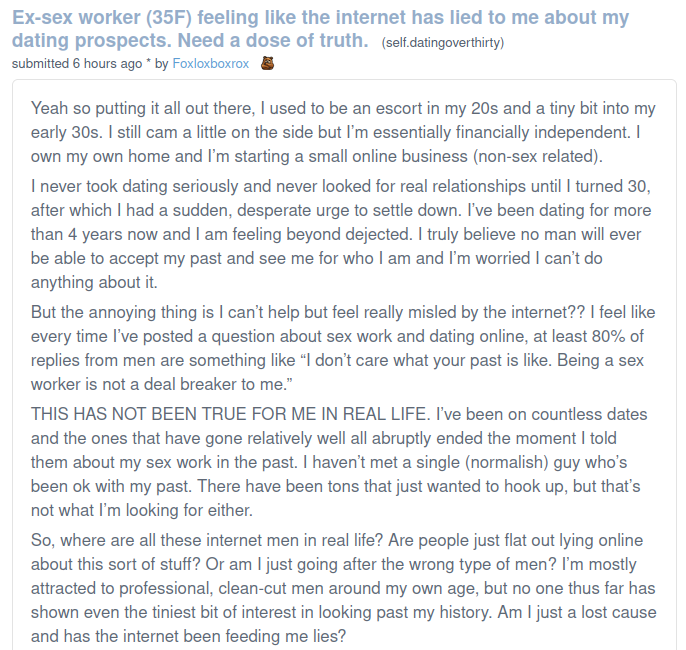
Here we see the development of a false consensus in this woman’s mind. How could the feedback she received online be so different from what the “normal” men she wants to date think? The Internet is a haven for loud voices and ideologues. Further, we self-select into communities of interest. It’s easy to form beliefs and attitudes from biased exposure that is unrepresentative of what the general population thinks.
Given that, let’s look at some past research on OnlyFans and then the data from our large survey of attitudes toward OnlyFans work and subscription.
Background Research
Litam et al. (2022) found that OnlyFans users were predominately white, married, and male heterosexuals. Additionally, users of OnlyFans scored similar to nonusers on the Brief Sexual Attitudes Scale assessing sexual permissiveness, attitudes toward birth control, communion (the emotional importance of sex), and instrumentality (the purpose of sex). Litam et al. also found few differences between men and women in attitudes related to OnlyFans use.
In a qualitative study of 22 OnlyFans workers, Hamilton et al. (2022) found three clusters of motivations for content creation on OnlyFans beyond its financial appeal as gig work: the growing social acceptance of OnlyFans, ease of OnlyFans platform use, and the COVID-19 pandemic. OnlyFans content creators were motivated by financial gain, but also by sexual expression and influence from peers and celebrities to join the platform. Bosworth (2022) similarly found that the COVID-19 pandemic was a motivation for OnlyFans content creation. Further, the growing social commodification of sex in conjunction with messages of empowerment may drive the motivation to create sexual content on OnlyFans (Halvorsen, 2022).
Although a major motivation to create content on OnlyFans is financial gain, as a form of gig work OnlyFans is precarious employment (Easterbrook-Smith, 2023). Exact figures on OnlyFans income are difficult to come by, but average earnings have been estimated to be as as low as $150 to $1000 per month. Vallina et al. (2023) calculated the average income of OnlyFans creators at $2,900. However, this was not a symmetrical distribution: 94% of OnlyFans creators generated below the average income and in Western nations 98% of OnlyFans creators earned an income that was below the national average. Most OnlyFans creators are unable to support themselves solely through the platform (McCluskey, 2023). OnlyFans content creators may also perform a great deal of uncompensated labor and many are left in economically vulnerable positions (Safaee, 2021; Smith, 2021). OnlyFans may appear at first as a potentially lucrative venue, given the media prominence of high earners and the celebritization of OnlyFans (McCluskey, 2023). However, the average OnlyFans content creator is simply not making that much money from it and usually cannot support themselves financially from it.
A recent literature review of the mental health of pornography performers (Jarke, 2022) found that although the research is scant, most indicates significantly poorer mental health when compared with the general population. None has been conducted on OnlyFans workers, who may operate under different conditions from conventional pornography. However, engagement in “raunch culture” may create a pathway to depression through negative social comparisons prominently in women (Sinclair & Jordan, 2023). Adding a sexual element to an already negative perception to oneself can exacerbate depression as one spends more time on sexualized social media. The typical question may be raised about the direction of the relationship: does producing pornography result in poorer mental health or are creators more likely to have poor mental health from the outset?
Cunningham & Kendall (2010) highlight how the safety of online sex work versus on-the-streets sex work creates better outcomes. Sex workers who have transitioned online may have a better quality of life insofar as marriage, lower rates of drug addiction, and fewer psychopathologies. Cunningham & Kendall also highlight how sex workers have more safety online to screen clients and may contract fewer STDs. Online sex work may also reduce the need for sex trafficking and exploitation. However, OnlyFans content creation may also occur in conjunction with sex work. Traditional venues for sexual performance, such as strip clubs, have often doubled as brothels where sex may be sold. Rather than leading creators away from selling sex, OnlyFans may function as a gateway into it. If OnlyFans is an insufficient income in itself then the motivation to pursue sex work can be high.
Relatively little quantitative research has been done on sex work and virtually none has been done on OnlyFans content creation. Existing research indicates that OnlyFans content creators may not be getting out of it what they desire — financial independence. Media has normalized and even glorified sex work, in particular within certain ideological subcultures. Researchers of sex work often avoid asking questions that they believe may stigmatize sex workers. We tend to assume the public has negative perceptions of sex workers and OnlyFans content creators, but no research has been done attempting to quantify popular negative perceptions of OnlyFans content creation.
Human beings are highly social animals and the way we are perceived by peers is important for our self-esteem, our romantic relationships, and future outcomes in our lives (Suls et al., 2002). It may be the case that women are being sold a bill of goods if they believe that OnlyFans will be a lucrative, empowering career, when financial returns are low and the stigma is high. Further, individuals may self-isolate within ideological communities and come to perceive that consensus is high on the acceptability of sex work when it really is not. The phrase “sex work is work” is common in far-left spaces, individuals who are labeled or who self-identify as “woke,” but to what extent are positive and supportive perceptions of sex work really held?
Young adults have to consider their careers and how to establish themselves financially going forward. However, romantic relationships are also an important part of our lives and there may be social consequences for engaging in sex work such as OnlyFans content creation. The consequences that emerge as young adulthood passes away and individuals begin to look toward a stable romantic future can be high. Trends in psychological research today may be afraid to simply tell it like it is in their desire to avoid stigmatization: sex work early in life may harm you later in life. There may be financial and romantic consequences for pursuing an OnlyFans gig. You have a permanent record online of your behavior and you may not want the explicit photos you sold for $150 at age 20 haunting you when you are 35. In the drive to attain an unrealistic income you may be doing irreversible damage to your future. You might have regrets and wish to put your past behind you, but find that you are unable to. Additionally, you may have been misled by a false social consensus that this is perceived as more acceptable behavior than it really is.
Methodology
We collected a sample of 1010 participants from a social media convenience / snowball sample. For participants, we collected demographic information on sex, age, sexual orientation, polyamory/monogamy, marital status, education, background in a religious household, and parenthood status.
Additionally, we asked participants if they desired to have children or desired to get married. We also asked participants for perceptions of the social harms of OnlyFans, potential consequences of OnlyFans use, and approval of a son/daughter or parent doing work on OnlyFans.
To test associations between ideological attitudes and OnlyFans work/subscription we created a novel “Woke Scale,” asked participants if they self-identified as “woke,” asked for political leaning (left or right), and feminist self-identification.
Results
Descriptive Statistics of the Sample
1010 total participants were surveyed (22.2% female). 80.8% were heterosexual, 17.6% bisexual, and 1.6% gay/lesbian. The mean age was 31 (SD 9.4).
The mean score on political ideology (1 = far left, 7 = far right) was 3.7 with a standard deviation of 1.4. The mean of self-reported religiosity was 2.34 (SD 1.8).
18.9% of the sample was married, 16.6% had children, 48.9% grew up in a religious household, and 14.4% indicated that they were polyamorous.
22.1% of the sample had a high school diploma or below, 48.8% had a Bachelor’s degree, 19.3% had a Master’s degree, and 9.8% had a PhD or professional degree.
21.8% of participants responded “yes” to the question, “Thinking of the term “woke,” would you describe yourself this way or do you believe others might describe you this way?” 71.7% responded “no” and 6.5% responded “I do not know what that is, or I am unsure.”
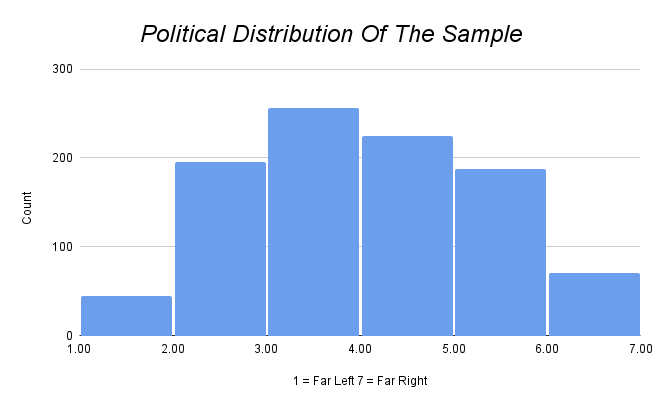
Woke Scale Validation
A reliability analysis was performed to assess the internal consistency of the Woke Scale (WS). Cronbach’s alpha indicated good reliability (α = 0.83). The average inter-item correlation was 0.39.
An exploratory factor analysis of the WS was conducted using the “minres” method in R with Promax rotation. The (RMSR) was 0.07, indicating a reasonable fit. The Tucker Lewis Index of Factoring Reliability (TLI) was 0.825, indicating variables are fair representations of the underlying construct (let’s call it wokeness). RMSEA was 0.137 (90% CI[0.125, 0.149]), indicating an acceptable fit. The factor’s correlation with regression scores is 0.94, the multiple R square of scores with the factor is 0.89, and the minimum possible factor score correlation is 0.77. A single factor explained 42% of the variance in WS scores.
Overall, the factor analysis indicates that a single factor can account for a large proportion of the variance in WS scores. WS items are closely related and can be summarized by a single factor. The model has reasonable fit, good reliability and adequate factor scores.

Woke Scale Associations


Participants were asked, “Thinking of the term “woke,” would you describe yourself this way or do you believe others might describe you this way?” A t-test was conducted to compare the mean WS scores of the “woke” group (M = 38.83) and the “not woke” group (M = 22.87). The t-statistic was 27.58 with 411.63 degrees of freedom, and the p-value was less than .001, indicating significant difference between the two groups. The 95% confidence interval for the difference in means ranged from 14.82 to 17.10. Cohen’s d was 2.04, indicating a large difference in WS scores between groups. Self-assessment of being “woke” was a strong predictor of scoring higher on the WS.
A Pearson’s correlation was conducted to examine the relationship between age and WS score. The correlation was not statistically significant, (r = -.05, p = 0.15, 95% CI [-0.11, 0.07]).
Political identification was strongly correlated with WS score (r = -0.76, p < 0.001, 95% CI [-0.79, -0.73]). Participants who were more left-leaning scored higher on the WS. Feminist self-identification was also highly correlated with WS score (r = 0.70, p < 0.001, 95% CI [0.67, 0.73]). Self-assessed religiosity was inversely correlated with WS scores (r = -0.30, p < 0.001, 95% CI [-0.36, -0.24]); participants who were more religious had lower WS scores.
A one-way analysis of variance (ANOVA) was conducted to examine the relationship between level of education and WS scores. The effect of education on WS scores was not significant (F(3, 1005) = 2.132, p = 0.095. An ANOVA was also performed for sexual orientation. Gay/lesbian and bisexual participants scored significantly higher (M = 37.3 and 36) than heterosexual participants (M = 25.1) (F(2, 1006) = 26.59, p < .001, η² = .248. A Tukey post hoc test indicated that there were significant differences between the heterosexual-bisexual and heterosexual-gay/lesbain groups (ps < .05).
There was no significant difference in WS scores for married vs unmarried participants, participants who grew up in a religious household vs those who did not. Participants who had children had lower WS scores (M = 25.4) than those who did not (M = 27.3) (p = .027, d = -.19). Additionally, participants who indicated they planned to have children had lower WS scores (M = 25) than those who did not plan to have children (M = 30.8) (p < .001, d = -.57). Participants who indicated they planned to get married had lower WS scores (M = 26.4) than those who did not (M = 28.6) (p = .007, d = -.21). Monogamous versus polyamorous self-identification predicted differences in WS scores, with monogamous participants scoring lower on average (M = 26) than polyamorous participants (M = 32.8) (p < .001), d = -.65).

Positive attitudes toward OnlyFans (OFAttitudes) (r = 0.56, p < 0.001, 95% CI [0.51, 0.60]), beliefs that OnlyFans is harmful (HarmItems) (r = -0.50, p < 0.001, 95% CI [-0.54, -0.45]), and approval of a family member working on OnlyFans (ApproveFamily) (r = 0.56, p < 0.001, 95% CI [0.52, 0.60]) were all significantly associated with WS scores.
Three items were used to assess perceptions of motivation for working on OnlyFans. WS scores were positively correlated with the belief that sexual desire is a high incentive to work on OnlyFans (r = 0.20, p < .001, 95% CI [0.14, 0.26]), that empowerment is a high incentive to work on OnlyFans (r = 0.27, p < 0.001, 95% CI [0.22, 0.33]), and that money is a high incentive to work on OnlyFans (r = 0.09, p = 0.00273, 95% CI [0.03, 0.16]).
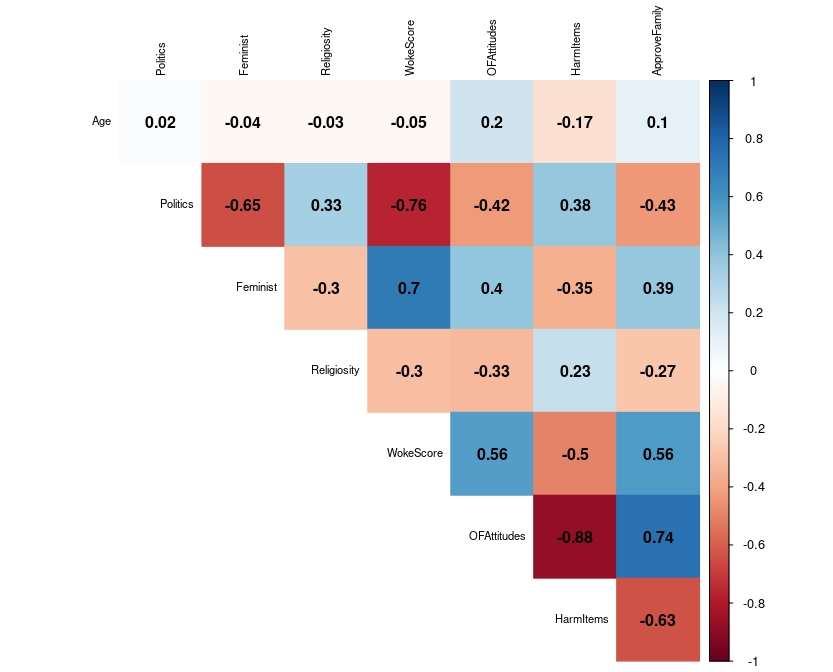
Approval of a Family Member Doing OnlyFans
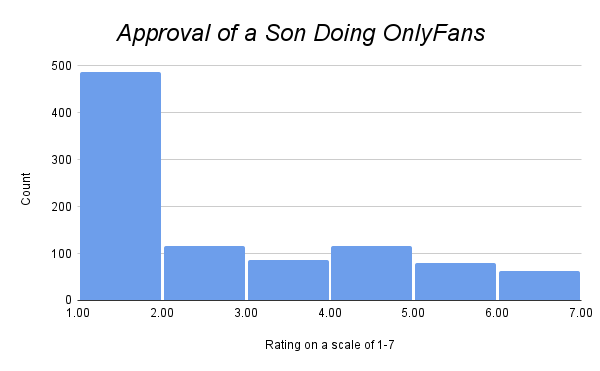
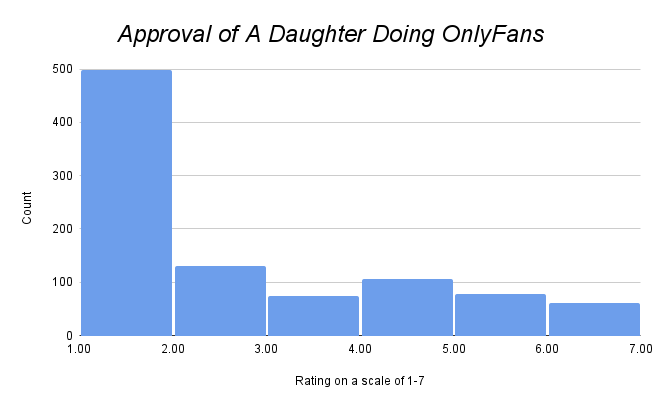
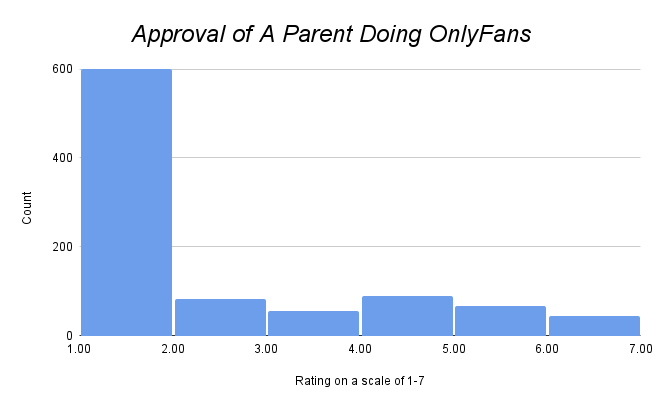
Correlations between WS scores and approval of sons (r = .51), daughters (r = .55) and parents (r = .51) were all significant (all ps < .001). Political identification was also correlated with approval of sons (-.43), daughters (-.42), and parents (-.39) working on OnlyFans (all ps < .001).
A Wilcoxon rank sum test was performed to assess sex differences in approval of a family member doing OnlyFans. No differences were found for men and women in approval of their son, daughter, or parent working on OnlyFans (all ps > .05). Mean scores were 2.6 for sons, 2.6 for daughters, and 2.4 for parents on a scale of 7.
Differences emerged for current OnlyFans workers and nonworkers. Participants who were current OnlyFans workers were more likely to approve of a son doing OnlyFans (M 4.2 vs 2.6, p < 001., d = .88), a daughter doing OnlyFans (M 4.4 vs 2.5, p < .001, d = .99), and a parent doing OnlyFans (M 4.4 vs 2.3, p < .001, d = 1.04).

Participants who indicated that they were current OnlyFans subscribers were also more supportive of family members doing OnlyFans (all ps < .001).

Participants who indicated that they planned to have kids were less supportive of a family member doing OnlyFans (all ps < .001).

However, there were no differences for participants who had children when compared with those who did not in support of a family member doing OnlyFans (all ps > .05).

Participants who indicated that they planned on getting married were less supportive of a family member doing OnlyFans (all ps < .001).

However, participants who were currently married were more supportive of a family member doing OnlyFans (all ps < .01).

Participants who indicated they were polyamorous rather than monogamous were also more supportive of a family member doing OnlyFans (all ps < .01).

Willingness to Date OnlyFans Workers and Subscribers
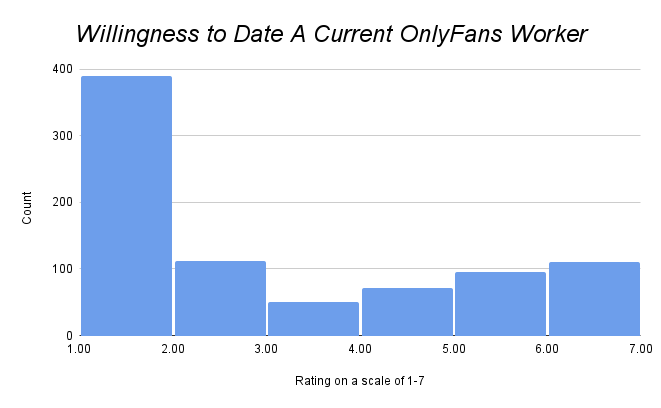
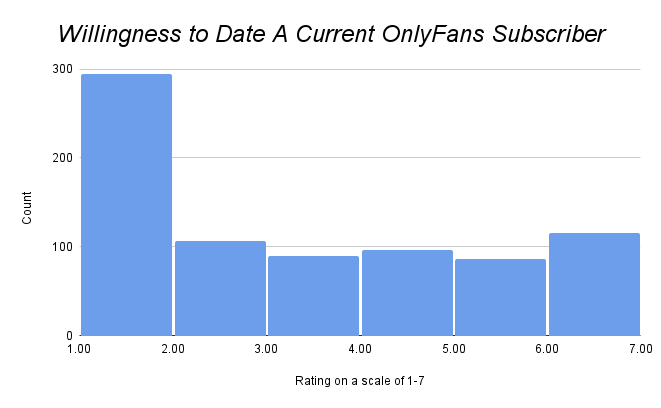
WS scores were correlated with a willingness to date and marry current and former OnlyFans subscribers (all ps < .001, rs = .39 to .41). WS scores were also correlated with a willingness to date and marry current and former OnlyFans subscribers (all ps < .001, rs = .50 to .53).
Political ideology was correlated with a willingness to date and marry current and former OnlyFans subscribers (all ps < .001, rs = -.33 to -.34). Political ideology was also correlated with a willingness to date and marry current and former OnlyFans workers (all ps < .001, rs = -.40 to -.45).
Men were more willing to date and marry current and former OnlyFans subscribers than women were (all ps < .001).

Men were more willing to date current and former OnlyFans workers (all ps < .05), but were not more willing to marry current or former OnlyFans workers.

Participants who planned to get married indicated that they were less likely to date or marry current OnlyFans workers. They were also less likely to date a former OnlyFans worker, but were not less likely to marry a former OnlyFans worker.

Participants who planned to have children also indicated that they were less likely to date or marry current and former OnlyFans workers.

Perceptions of OnlyFans Workers’ Intelligence
We asked participants to indicate how intelligent they believed the average OnlyFans worker to be (as estimated by IQ scores). The mean was 98.9, indicating that participants on average believed OnlyFans workers to be of average intelligence (an IQ of 100 was indicated in the instructions as average intelligence).
Men and women did not differ in perception of OnlyFans workers’ intelligence (M 99.6 vs 98.7) (p = 0.09). A positive correlation emerged for WS scores and perceptions of OnlyFans workers’ intelligence (r = .34, p < .001).
Participants who planned on having children estimated the average IQ of OnlyFans workers to be lower than those who did not (M 98 vs 101) (p < .001, d = -.43). Participants who planned on getting married also estimated the average IQ of OnlyFans workers to be lower than those who did not (M 98.5 vs 100) (p < .01, d = -.22).
Amount Desired to Do OnlyFans
Below are descriptive statistics comparing the monthly income that participants reported would be an incentive for them to do OnlyFans work. The first table compares men and women and the second table compares participants who self-identified themselves as “woke” versus those who were not. “Woke” participants were substantially more likely to say that they had some price and indicated prices lower on average than participants who were not “woke.”
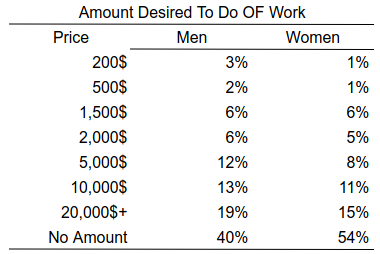

OnlyFans Workers & Subscribers
18 survey participants responded affirmatively that they were current or former OnlyFans workers. 66.7% of this group indicated that they had done sex work in addition to OnlyFans. The mean age of OnlyFans workers was 31.6 and was not significantly different from the mean age of the rest of the sample (31).
OnlyFans workers scored significantly higher on the WS (M = 33.7) than those who were not OnlyFans workers (M = 26.8) (p = .009, d = .67). OnlyFans workers were also significantly more likely to be left-wing (M = 2.9) than those who were not OnlyFans workers (M = 3.7) (p = .03, d = -.58).
OnlyFans subscribers were slightly older (M = 32.9) than the rest of the sample (M = 30.5) (p < .001, d = .26). OnlyFans subscribers had higher WS scores (M = 30.5) than the rest of the sample (M = 26) (p < .001, d = .42).
Below are comparisons of descriptive statistics for OnlyFans workers and subscribers versus participants who were not:
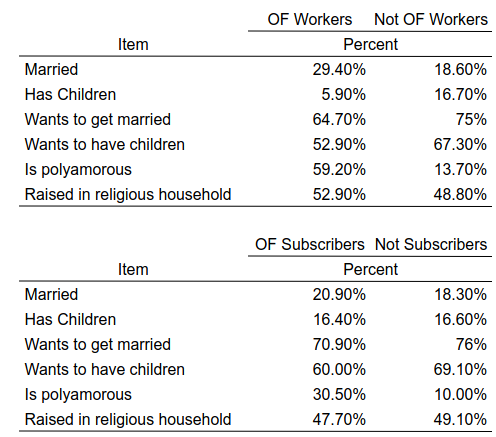
OnlyFans workers were asked to indicate on a 1-7 Likert scale three major incentives for doing OnlyFans work: sexual desire, empowerment, and financial gain. Only financial gain saw high agreement, with most of the sample indicating a 6 or a 7.
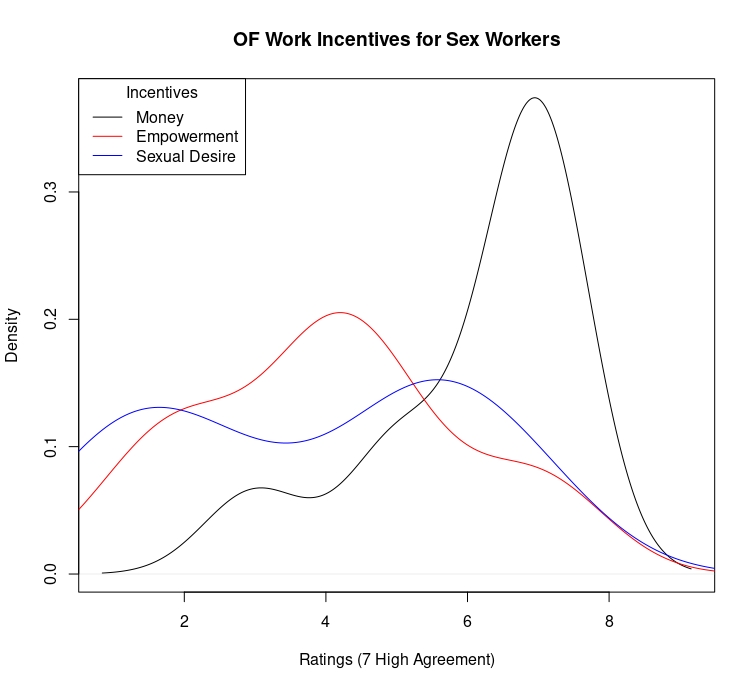
Result Summary
- Our novel Woke Scale was strongly predictive of self-recognition as “woke,” positive attitudes toward OnlyFans, self-identified left-wing political ideology, feminist identification, and low religiosity.
- Current OnlyFans workers, participants who did not plan on having children, participants who did not plan on getting married, and participants who were polyamorous were more likely to approve of a family member doing work on OnlyFans.
- Men were more willing than women to date current and former OnlyFans workers and OnlyFans subscribers. Women were less willing to date OnlyFans subscribers than men were to date OnlyFans workers.
- Participants who planned to get married or who planned on having children in the future were less willing to date or marry current or former OnlyFans workers or subscribers.
- Participants perceived OnlyFans workers as having average intelligence (IQ of 98). Participants who scored higher on the WS perceived OnlyFans workers as being more intelligent on average, while participants who planned on getting married or having children perceived OnlyFans workers as having lower intelligence.
- Approximately 54% of women and 40% of men said that no amount of money would be an incentive to do OnlyFans. Participants who self-identified as “woke” were substantially more likely to have a price for which they would be willing to do OnlyFans work.
- Money was the top motivation for OnlyFans work cited by participants who were OnlyFans workers. OnlyFans workers showed higher disagreement on empowerment and sexual desire as motivations.
Discussion
A consistent finding across our research was that participants who scored higher on the WS were more likely to think positively across the board pertaining to OnlyFans and the futures of OnlyFans workers. This is consistent with past research, which has consistently found that liberal political ideology is associated with more sexually permissive attitudes (Petersen, 2018). More optimistic attitudes for OnlyFans workers were found in the contexts of dating, marriage, having children, and future career prospects.
Contrary to the belief that women find empowerment or fulfill sexual desire through OnlyFans, our research shows that the main motivation for doing OnlyFans is money. Although some women may feel it is empowering or a venue for expressing their sexuality, OnlyFans workers’ responses were highly mixed and only a high consensus emerged that financial gain was a large motivation.
Participants who planned on getting married or having children had less positive perceptions of OnlyFans workers. These participants were less likely to approve of a family member doing OnlyFans, believed OnlyFans members had lower intelligence, and were also less willing to date or marry both OnlyFans workers and subscribers. Curiously, these differences were larger for participants who planned on getting married or having kids than for those who currently have children. This may be because a large number of OnlyFans subscribers are themselves married men with children (Litam et al., 2022). These results are also consistent with a body of research in evolutionary psychology indicating that individuals who have a higher orientation toward family and monogamy have more restrictive sexual attitudes (Luberti et al., 2023).
An interesting finding in our research is that, as far as dating and marriage are concerned, being an OnlyFans subscriber was worse to women than being an OnlyFans worker was to men. The mean score for women in the willingness to date an OnlyFans subscriber was 2.8. The mean score for men to dating a current OnlyFans worker was 3.6. Men may underestimate how undesirable being an OnlyFans subscriber is to women. Beyond merely watching pornography, OnlyFans may be a form of parasocial relationship with the investment (finances, emotional interaction) that men create with an OnlyFans worker. The act of investing financially and emotionally in an external relationship may represent an additional threat beyond the perceived sexual infidelity of pornography use.
Slightly less than half of the women in the sample had a price for which they would do OnlyFans. 54% of the female participants said there was no price. The price for women who were willing to do OnlyFans was substantially higher than the average income most women receive on OnlyFans. According to Vallina et al. (2023), the average income women make on Onlyfans ranges from $150 to $2,900 per month. However, 94% of women made below this average. According to McKulskey (2023), the celebritization of OnlyFans has created a false impression of what is possible to achieve to the majority of OnlyFans workers. Women who consider OnlyFans should keep in mind that, if their price is high, they are unlikely to attain that.
Conclusion
OnlyFans workers likely have some awareness that they are in a stigmatized gig. Our results indicate that OnlyFans workers and subscribers both face barriers to forming future relationships, as a large percentage of the population indicates a low willingness to date or marry workers and subscribers. However, positive perceptions of OnlyFans, as well as the willingness to date OnlyFans workers and subscribers, are strongly associated with a subculture of “wokeness.” This may lead to a false consensus as to how others perceive sexual gig work. OnlyFans workers and subscribers may also ask themselves if this is the demographic — the “woke” — for whom they wish their mate pool to consist of.
In addition to our results, we must raise the issue of how the exchange between OnlyFans subscribers and OnlyFans workers can result in an exploitative relationship between both parties. Subscribers may be looking for an emotional connection beyond the sexual content. Meanwhile, the Onlyfans worker just sees the subscriber as a paycheck.
If the paycheck is what OnlyFans workers are after, as our results indicate, would-be OnlyFans workers may be disappointed. Very few are making the kind of money that most of our participants indicated would be sufficient motivation for them. Additionally, aside from an unrealistic idea of how much money can be made, being an OnlyFans worker can also impact one’s future relationship, family, and marital prospects. Family members may disapprove and this may negatively impact future career prospects when a worker eventually wants to leave, or when they age out of the business.
References
Bosworth, J. (2022). Sex Workers on OnlyFans: An Exploratory Investigation of Services Accessibility, Psychosocial Influences, and Online Culture (Doctoral dissertation, Rutgers The State University of New Jersey, Graduate School of Applied and Professional Psychology).
Cunningham & Kendall, T. D. (2011). Prostitution 2.0: The changing face of sex work. Journal of Urban Economics, 69(3), 273–287. https://doi.org/10.1016/j.jue.2010.12.001
McCluskey, M. (2023). OnlyFans: The Celebritization of Online Sexual Labour. Canadian Graduate Journal of Sociology and Criminology, 6(1).
Easterbrook-Smith, G. (2023). OnlyFans as gig-economy work: A nexus of precarity and stigma. Porn studies, 10(3), 252-267.
Halvorsen, M. S. K. (2022). Female empowerment through OnlyFans? A sociology of law analysis of tendencies and norms surrounding OnlyFans and the use of sex as a commodity in the digital realm (Master’s thesis).
Hamilton, V., Soneji, A., McDonald, A., & Redmiles, E. M. (2022). ” Nudes? Shouldn’t I charge for these?”: Exploring What Motivates Content Creation on OnlyFans. arXiv preprint arXiv:2205.10425.
Jarke, H. (2022). What do we know about the mental health of porn performers? A systematic literature review. Journal of public mental health, 21(2), 119-127.
Litam, S. D. A., Speciale, M., & Balkin, R. S. (2022). Sexual attitudes and characteristics of OnlyFans users. Archives of Sexual Behavior, 51(6), 3093-3103.
Luberti, F. R., Blake, K. R., & Brooks, R. C. (2023). Evolutionary Ecological Insights into the Suppression of Female Sexuality. Current Research in Ecological and Social Psychology, 100167.
McCluskey, M. (2023). OnlyFans: The Celebritization of Online Sexual Labour. Canadian Graduate Journal of Sociology and Criminology, 6(1).
Petersen, M. B. (2018). Reproductive interests and dimensions of political ideology. Evolution and Human Behavior, 39(2), 203-211.
Safaee, A. (2021). Sex, Love, and OnlyFans: How the Gig Economy Is Transforming Online Sex Work (Doctoral dissertation, San Diego State University).
Sinclair, G., & Jordan, D. G. (2023). Generation OnlyFans: Examining the Effects of “Raunch Culture” on Depression via Social Media Use and Social Comparisons. Sexuality & Culture, 27(2), 517-538.
Smith, A. (2021). OnlyFans is Booming. But For Whom?.
Suls, J., Lemos, K., & Stewart, H. L. (2002). Self-esteem, construal, and comparisons with the self, friends, and peers. Journal of Personality and Social Psychology, 82(2), 252.
Uttarapong, J., Bonifacio, R., Jereza, R., & Wohn, D. Y. (2022, April). Social support in digital patronage: OnlyFans adult content creators as an online community. In CHI conference on human factors in computing systems extended abstracts (pp. 1-7).
Vallina, P., Castro, I., & Tyson, G. (2023, April). Cashing in on Contacts: Characterizing the OnlyFans Ecosystem. In International World Wide Web Conference.
3 comments
Another article that just affirmed what everyone knew.lol
what a waste of fucking pixels
Great content! Thank you so much for your work!